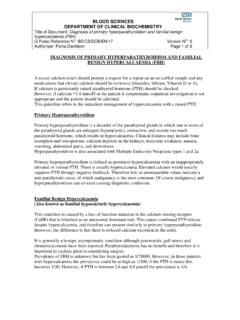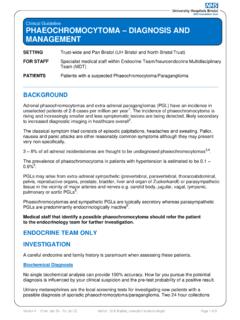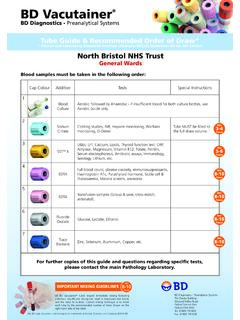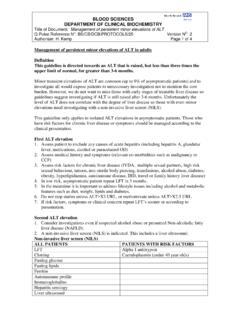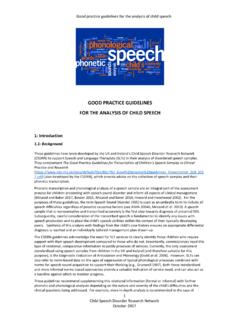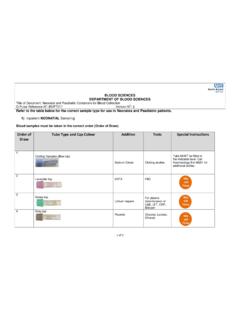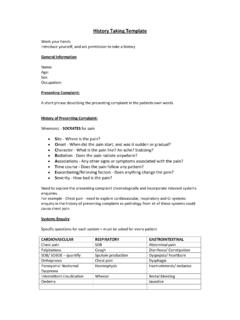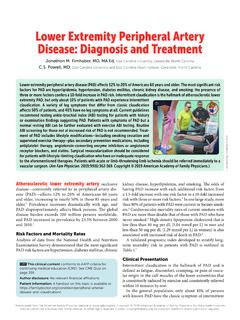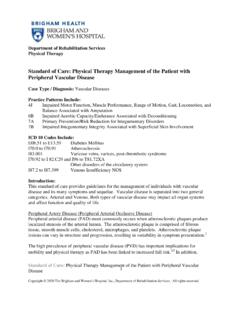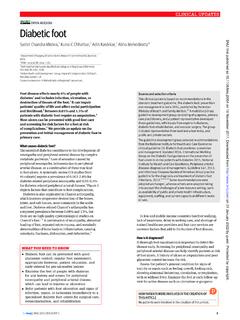Transcription of Exercise for Intermittent Claudication
1 Exceptional healthcare, personally deliveredExercise for Intermittent ClaudicationExercise for Intermittent Claudication2 Ask 3 Questions Preparation for your AppointmentsWe want you to be active in your healthcare. By telling us what is important to you and asking questions you can help with this. The three questions below may be useful: Exercise for Intermittent Claudication3 People suffering from Intermittent Claudication experience a cramping pain in their muscles when they walk or Exercise . Intermittent Claudication is caused by the muscles not getting enough oxygen due to narrowing or blockages in the the blockages causing Claudication never clear themselves, the smaller arteries in the leg may enlarge to carry blood around blockages.
2 This is called the collateral circulation. It is thought that Exercise can encourage the development of collateral circulation, causing smaller arteries to enlarge, allowing them to carry more blood, and therefore more oxygen to the muscles. There is also evidence that regular Exercise of the affected muscles can help them adapt to become less demanding of oxygen when you walk. This may take three to six months, so please be patient. The two things that are most effective at improving symptoms can be done by YOU:1. EXERCISE2. STOP SMOKING If you do these things we know: 50% of people with symptoms get better within 5 years Less than 25% of people have symptoms that get worse Only 5% of people go on to have a procedure to improve the blood supply to leg Only 1-2% of people go on to lose their legsEXERCISE GIVES THE BEST LONG TERM RESULTS FOR PEOPLE WITH Claudication RECOMMENDS EXERCISEE xercise for Intermittent Claudication4 How often should I Exercise ?
3 You should walk or Exercise a minimum of three times per week for 30 minutes, although you may have to work up to that level if you are not used to doing that much activity. At the start of each week, look at your diary and plan when you will walk or Exercise and write it down. You can then write down the amount of Exercise you managed to achieve against each time you planned to hard should I Exercise ?To gain the maximum benefit, you need to work through the pain and try to maintain that level for a short period, then rest and try again. You should aim to increase the time you can Exercise without rest. It is good to push through your Claudication pain, but if you are getting significant pain elsewhere, for example in joints or your chest, please see your GP and discuss your concerns.
4 What kind of exercises can I do other than walking? Exercise classes can be very helpful for patients with Intermittent Claudication . These are the following Exercise routines you can do at home, or may do in a supervised Exercise for Intermittent Claudication5 Aim for eight minutes on each exerciseStep upsStep up so both feet are on the upper step, then step down again. Change leading leg every 10 walkingWalk up and down on your tip toes wherever there is room, for example in your hall or on a garden raisingHold onto a chair or kitchen surface. Then rise up onto your toes and lower. Aim to try on one for Intermittent Claudication6 Stretching is really important at the end of these twice on each leg, holding the position for five stretchWith both feet facing forward, bend your front knee and keep your back heel on the floor.
5 Transfer your weight onto your front stretchStand on your back leg with your knee slightly bent and the heel of your front leg on the floor, and pull your toes towards stretchStand on one leg, holding on for balance. Bring your foot up towards your bottom, holding onto your foot or trouser leg. Try to keep your knees and thighs for Intermittent Claudication7 What other changes to lifestyle can help?There are several things you can do that may help. In addition to regular Exercise if you want to walk further you can: Stop smoking Eat a varied and balanced diet low in fat, salt and added sugars to prevent becoming overweight If you have diabetes, ensure that it is well controlled Have your blood pressure and cholesterol levels checked by your GP.
6 Managing these well in addition to an antiplatelet medication and a statin reduces you risk of heart attack and stroke. Take good care of your feet. Check between your toes and the underside of your feet with a mirror if they are difficult to reach. If you are diabetic always wear well-fitting shoes and avoid walking around in bare feet. Your GP can refer you to a podiatrist if can I learn more about Claudication ?You have been provided with this leaflet to give you information about a treatment option for Intermittent Claudication . Other leaflets about Claudication are available and we recommend you read in these for Intermittent Claudication8 Where can I find out more about this condition?We recommend the following websites for more information about vascular surgery conditions and treatments:The Circulation Vascular Society of Great Britain & for Vascular Surgery (USA) Institute for Clinical Excellence (NICE) for Intermittent Claudication9 Where can I find out more about my specialist?
7 North Bristol NHS Trust Society of Great Britain & you or the individual you are caring for need support reading this leaflet please ask a member of staff for advice. North Bristol NHS Trust. This edition published January 2018. Review due January 2020. NBT003055
